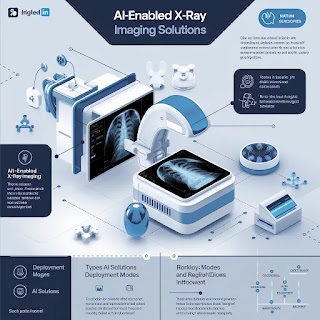Revolutionizing Healthcare: The Explosive Growth of AI-Enabled X-Ray Imaging Solutions Market
The healthcare industry is witnessing a profound transformation as artificial intelligence reshapes traditional diagnostic practices. At the forefront of this revolution is the AI-enabled X-ray imaging solutions market, which has emerged as one of the most dynamic and rapidly expanding segments in medical technology.
Request a Sample: https://www.futurewiseresearch.com/contact.aspx?rpt=14182&type=requestsample
Market Dynamics and Growth Trajectory
The global AI-enabled X-ray imaging solutions market is
valued at USD 184.5 million in 2024 and is predicted to reach USD 978.9 million
by 2034, representing a robust compound annual growth rate (CAGR) of 18.3%.
However, market projections vary across different research firms, with some
forecasting even more aggressive growth patterns. Alternative estimates suggest
the market could reach USD 2,218.11 million by 2032, growing at a CAGR of
21.60%, highlighting the sector's immense potential and the varying methodologies
used in market analysis.
This exponential growth reflects the healthcare industry's
increasing recognition of AI's transformative potential in diagnostic imaging.
The technology is not merely an enhancement to existing systems but represents
a fundamental shift in how medical professionals approach radiological
interpretation and patient care.
Driving Forces Behind Market Expansion
Several key factors are propelling the AI-enabled X-ray
imaging solutions market forward. The steady expansion of the healthcare
industry globally provides a robust foundation for growth, while technological
advancements continue to unlock new possibilities for AI integration in medical
imaging workflows.
Healthcare providers are increasingly recognizing that
AI-powered X-ray solutions offer significant advantages over traditional
imaging approaches. These systems can detect subtle abnormalities that might
escape human observation, reduce diagnostic errors, and accelerate the
interpretation process. The ability to provide consistent, accurate results
regardless of operator experience level makes these solutions particularly
valuable in resource-constrained environments or areas with limited access to
specialized radiologists.
The growing demand for early disease detection and
preventive healthcare is another crucial driver. AI algorithms can identify
patterns and anomalies in X-ray images that indicate the early stages of
various conditions, from pneumonia and tuberculosis to bone fractures and
cardiovascular issues. This capability aligns perfectly with the global shift
toward preventive medicine and value-based healthcare models.
Technological Innovations and Applications
Modern AI-enabled X-ray imaging solutions leverage
sophisticated machine learning algorithms, including deep learning and neural
networks, to analyze radiological images with remarkable precision. These
systems are trained on vast datasets of annotated X-ray images, enabling them
to recognize patterns associated with specific medical conditions.
The applications span numerous medical specialties,
including emergency medicine, orthopedics, pulmonology, and cardiology. In
emergency departments, AI systems can prioritize critical cases by rapidly
identifying life-threatening conditions, ensuring that patients receive timely
care. Orthopedic applications include automated detection of fractures and
joint abnormalities, while pulmonary applications encompass screening for lung
diseases and monitoring treatment progress.
Market Challenges and Future Outlook
Despite the promising growth trajectory, the AI-enabled
X-ray imaging solutions market faces several challenges. Regulatory approval
processes remain complex and time-consuming, particularly as healthcare
authorities work to establish comprehensive frameworks for AI medical devices.
Data privacy and security concerns also require careful attention, as these
systems handle sensitive patient information.
Integration with existing healthcare IT infrastructure
presents another challenge, as hospitals and clinics must ensure seamless
workflow integration without disrupting established practices. Training
healthcare professionals to effectively utilize these AI tools while
maintaining their clinical judgment skills is equally important.
Conclusion
The AI-enabled X-ray imaging solutions market represents a
compelling intersection of technological innovation and healthcare necessity.
With market valuations projected to increase by 400-500% over the next decade,
this sector offers significant opportunities for technology companies,
healthcare providers, and investors alike.
As AI algorithms become more sophisticated and regulatory frameworks mature, we can expect to see broader adoption of these solutions across healthcare systems worldwide. The ultimate beneficiaries will be patients, who will receive more accurate diagnoses, faster treatment decisions, and improved health outcomes through the power of artificial intelligence in medical imaging.




Comments
Post a Comment